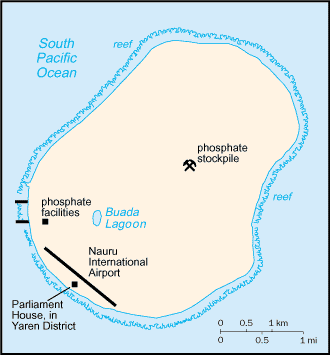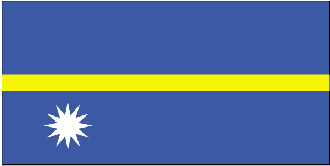
|
Nauru
Background:
Nauru's phosphate deposits began to be mined early in the 20th century by a
German-British consortium; the island was occupied by Australian forces in
World War I. Nauru achieved independence in 1968 and joined the UN in 1999.
Nauru is the world's smallest independent republic.
Location:
Location: Oceania, island in the South Pacific Ocean, south of the Marshall
Islands.
Area: total: 21 sq km.
Area - comparative: About 0.1 times the size of Washington, DC.
Coastline: 30 km.
Climate and Terrain:
Climate: Tropical; monsoonal; rainy season (November to February).
Terrain: Sandy beach rises to fertile ring around raised coral reefs with
phosphate plateau in center.
Natural resources: Phosphates, fish.
Geography - note: Nauru is one of the three great phosphate rock islands in the
Pacific Ocean - the others are Banaba (Ocean Island) in Kiribati and Makatea in
French Polynesia; only 53 km south of Equator.
People:
Population: 12,570.
Ethnic groups: Nauruan 58%, other Pacific Islander 26%, Chinese 8%, European
8%.
Religions: Christian (two-thirds Protestant, one-third Roman Catholic).
Languages: Nauruan (official, a distinct Pacific Island language), English
widely understood, spoken, and used for most government and commercial
purposes.
Government:
Government type: Republic.
Capital: No official capital; government offices in Yaren District.
Independence: 31 January 1968 (from the Australia-, NZ-, and UK-administered UN
trusteeship).
Economy overview:
Revenues of this tiny island have come from exports of phosphates, but reserves
are expected to be exhausted within a few years. Phosphate production has
declined since 1989, as demand has fallen in traditional markets and as the
marginal cost of extracting the remaining phosphate increases, making it less
internationally competitive. While phosphates have given Nauruans one of the
highest per capita incomes in the Third World, few other resources exist with
most necessities being imported, including fresh water from Australia. The
rehabilitation of mined land and the replacement of income from phosphates are
serious long-term problems. In anticipation of the exhaustion of Nauru's
phosphate deposits, substantial amounts of phosphate income have been invested
in trust funds to help cushion the transition and provide for Nauru's economic
future. The government has been borrowing heavily from the trusts to finance
fiscal deficits. To cut costs the government has called for a freeze on wages,
a reduction of over-staffed public service departments, privatization of
numerous government agencies, and closure of some overseas consulates. In
recent years Nauru has encouraged the registration of offshore banks and
corporations. Tens of billions of dollars have been channeled through their
accounts.
Statistics:
Telephones - main lines in use: 2,000.
Telephones - mobile cellular: 450.
Radio broadcast stations: AM 1.
Radios: 7,000.
Television broadcast stations: 1.
Televisions: 500.
Railways: Total: 5 km.
Highways: Total: 30 km, paved: 24 km, unpaved: 6 km.
Airports: 1.
Return to Visiting Locations
|

